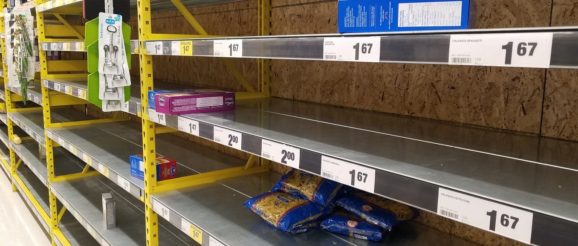Supply chain innovation can reduce coronavirus food shortages


Food security is an essential issue brought to light by COVID-19.
The Canadian government recognized this by deeming workers across the food supply chain as an essential service. More importantly, in early May, the federal government announced $252 million in funding to farmers, food processors and food businesses to get through this pandemic.
Of the funding, $77.5 million is earmarked for food processing. This is a critical juncture: we are at a time when we need to examine food processing technology pre-COVID-19 and deploy it to make us more food secure and ready to withstand the next big challenge.
Relying on old approaches
With COVID-19, we’ve fallen back to 19th-century food technology to make us feel safe—stocking our pantries with canned foods and shelf-stable dried foods, including grains and pulses.
When considering a post-COVID-19 food system, we must focus on building resilience using modern innovation. Cutting costs should not be the only factor that informs our supply chains.
Most Canadians have lifestyles that demand the convenience of processed foods while valuing nutrition. The carbon footprint of food preservation done at the industrial scale is low: life-cycle analyses of foods show that the carbon footprint of home cooking is 2.5 times that required to process the food.
Food supply innovation tools
In designing this post-COVID-19 food system, the innovation tools are remarkably like the technology-focused terms of the pre-COVID-19 food system. Some examples are:
Refrigeration and transportation
Because most foods are perishable, refrigeration or freezing is required to preserve the food from production to consumption—a continuous system of temperature-controlled environments known as the cold chain. All of this cold chain, including the limited amount of cold-space in a consumer household, is completely reliant on uninterrupted power for refrigerant recycling.

Developing nutritious shelf-stable food innovations also addresses the cold chain’s carbon footprint. As much as 80 percent of the emissions profile of a food product is its refrigeration footprint. More than half of all supermarket energy consumption is associated with their fridge and frozen aisles. Innovative drying practices can replace these cold chains to preserve fruits and vegetables, at the same time maintaining quality and nutrients.
Finance Minister Bill Morneau noted that Canada’s agricultural sector is interconnected.
As we enter the post-COVID-19 world of the 21st century, our call to action is to renovate our food supply chains so that they readily absorb the effects of the next big challenge. It’s now up to all the food system actors represented on the Canadian Food Policy Advisory Council to ensure the new investments make a positive and lasting change across the production chain to benefit both consumers and the environment.
This article is republished from The Conversation under a Creative Commons license. Read the original article.![]()
Supply chain innovation can reduce coronavirus food shortages (2020, June 1)
retrieved 1 June 2020
from https://phys.org/news/2020-06-chain-coronavirus-food-shortages.html
part may be reproduced without the written permission. The content is provided for information purposes only.
